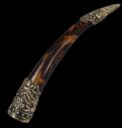Guarding nails, then and now
Besides Cixi’s extravagant attire, you might have noticed her long nails and especially the jade finger guards on her left hand. Those fingernail guards are called 指甲套 zhijiatao (literally: fingernail covering) or 護指 huzhi (finger protection) in Chinese. They originated from the Ming Dynasty and became popular in the Qing dynasty. Cixi herself wore these fingernail guards on a regular basis.
They were used by women to protect their long nails from breaking. In ancient China it was customary for nobility to have long fingernails, which were seen as a symbol of wealth, as having long nails would hinder a person from doing menial tasks. That’s why only nobility could afford to let their nails grow long, since they did not have to work and had servants who would help them with those tasks. Women usually had longer nails than men, which may be the reason we only see the fingernail guards being worn by women in pictures and paintings, considering that long nails are much more fragile and need protection. Not only does it protect the nails, it also makes the fingers look slimmer. Fingernail guards come usually in pairs and they can be worn on one hand only, or on both hands. From what we can see in pictures, paintings and sources, these guards were worn on the fourth finger and the pinky. Katherine mentioned them in her book in the following way:
She wore bracelets and rings, and on each hand had two nail protectors, for she wore her nails so long the protectors were necessary adjuncts. These nail protectors were worn on the third and fourth fingers of either hand; those on the left being of brilliant green jade, while those on the right hand were of gold, set with rubies and pearls.[Cf, p 9] A second reason why people let their nails grow out can be explained by the following passage from the Analects of Confucius (孝經):
The master said: Our body, from our hair to our skin, is received by us from our parents. We must not injure or wound them. This is the beginning of filial piety.(孔子云:身體髮膚,受之父母,不敢毀傷,孝之始也)
This passage suggests that everything of the body should be kept intact, because it signifies respect towards one’s parents by not “harming” one’s own body. A fingernail guard can help to reach that goal.
These fingernail guards were usually made of luxurious materials such as jade, silver, gold or tortoiseshell, then inlaid with precious gems and various auspicious motifs to show off the wealth of the wearer. However, the nails had to be protected at all times, especially during sleep when fingernails can accidentally break. That’s why the women wore wooden nail guards in bed.
In the present, there are still men who let their pinky fingernail grow long as a way to either attract wealth or to show off that they are wealthy and don’t have to do manual labour. Furthermore, we can see traces of the fingernail guards in the nail industry. Nail art styles are becoming more complex and the length keeps increasing. Just like nail guards, it is a way to protect nails from breaking and it is also for aesthetic purposes. Though nail art and fingernail guards don’t necessarily have a direct correlation, it is still very interesting how certain trends can repeat themselves in an adapted form.



